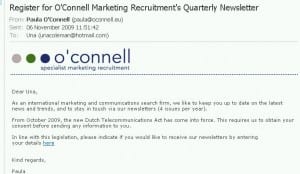Changes are a coming…
You don’t have to be a marketing expert anymore to put an ezine together or blast your prospects with an e-marketing campaign or a cool survey. They are all great ways to engage with your customers and Web 2.0 has given us fantastic, easy to use tools. However, there is a downside to having access to this functionality at the click of our fingertips: Mail Overload. We all get them – newsletters with nothing to say (or, too much to say), service offerings that have no relevance to our businesses, no personalisation, or the one that for me guarantees a send to blocked emails, “Dear Coleman”. The sender hasn’t bothered to check my name: so much for customer care. That’s why I say you don’t have to be a marketing expert… Need I say more!
Outbound – email marketing
Unfortunately, the down-side is that our email is rapidly becoming our most protected piece of personal data. We tweet intimate (and inane) details of our personal lives, we post personal and family pictures on Facebook, we upload embarrassing videos on YouTube, all for the world to see. But, we hold control of our emails sacrosanct: we are becoming ever more intolerant of interruption based or outbound marketing.
This desire to be in control and decide with whom we wish to correspond is driving inbound and permission based marketing. Equally, it is driving ever more stringent data-protection rules. Warning: DON’T FALL FOUL OF DATA PROTECTION LEGISATION
Outbound – tele and direct marketing
And it’s not just email marketing: regulation also applies to direct marketing and telemarketing. New EU regulation is coming into place the end of this year. You need to ensure you are familiar with the local legislation in each of the countries you operate.
From October 2009, an amendment to the Dutch Telecommunications Act has come into force establishing new rules for business to business email marketing. Primarily, prior consent must be obtained from the receiver if his/her email address is to be used for future commercial purposes. If you have an existing newsletter with Dutch email addresses you MUST obtain their consent before sending another newsletter. You may send an email under separate cover instructing them to “opt in” to continuing to receive your newsletter by replying to that email. Without a confirmation to that email, you are prohibited by law to email that person again. You have until the end of December to ge that consent. There are nuances to the legislation and of course, where an established relationship exists as a result of the sale of goods and services permission is deemed to exist.
The amended to the Dutch Telecommunications Act is extreme but likely to set the standard for the future.
In addition to B2B email marketing, there are new and severe restrictions on outbound telemarketing activity.
All telemarketers MUST offer a do not call to prospects and register that number, as part of the call script.
Fines and penalties

In the case of the Netherlands, OPTA (www2.opta.nl/asp/en) is the supervisory authority. The can impose stiff fines up to € 450.000 in the case of telemarketing offences, or can go as far as temporarily closing down an organisation involved in outbound telemarketing
UK email rules are currently based on 2003 legislation. It is similar but not as restrictive as the Netherlands. Permission is required for “cold” emailing. You can continue to email exiting clients, without requesting permission, as long as the products and services you are offering are similar. If you are offering something new, then you need permission: http://www.ico.gov.uk/for_organisations/topic_specific_guides/marketing.aspx

This ever more restrictive legislation requires us to be more active and creative with our inbound, permission based marketing. Websites must radically change from static brochureware to engaging information gateways that help build your brand and draw your prospects back.
What are your thoughts? Will this make our task more difficult or will it make us more creative. I’d love to hear your comments.


